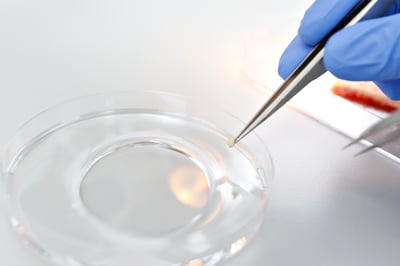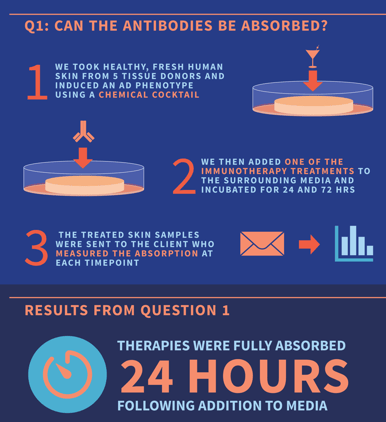Biopsies from Patients with Psoriasis or Atopic Dermatitis
REPROCELL offers advanced, clinically relevant skin models using tissues from living patients with skin diseases, or disease-like phenotypic models induced in normal skin.

Image: A full-thickness punch biopsy from a patient with skin disease.
Our models of disease in human fresh skin
- Skin from healthy donors; individual biopsies (20+ per donor) stimulated to create a disease-like phenotype (either atopic dermatitis or psoriasis)
- Skin biopsies from patients with atopic dermatitis (3 biopsies per donor)
- Skin biopsies from patients with psoriasis (3 biopsies per donor)
Our models provide invaluable insights for drug discovery and preclinical patient stratification. Here’s an in-depth look at our psoriasis and atopic dermatitis (AD) assays:
Atopic Dermatitis Disease Model Induced in Normal Skin
Our AD model is meticulously designed to simulate the inflammatory response characteristic of atopic dermatitis. Multiple (20+) biopsies are created from a single human skin specimen donated following surgery. A proprietary stimulation cocktail is used to induce the production of IL-5, IL-13, and IL-22 by the biopsies, replicating the cytokine profile observed in AD patients. The model’s responsiveness to steroid treatment validates its use as a control in evaluating new test articles. The availability of high numbers of biopsies from each donor, supports investigations across multiple test compounds or concentrations.
Psoriasis Phenotype Disease Model Induced in Normal Skin
To create a psoriasis-like phenotype in healthy human skin explants, we employ a test cocktail that activates the Th17/IL-17 pathway. By measuring changes in cytokine profiles or in gene expression post-incubation with your test article, we can assess the efficacy and safety of potential psoriasis treatments. This method allows high numbers of test conditions to be studied in skin biopsies isolated from each donor skin specimen.

Skin Models using Diseased Tissue from Patients with AD or Psoriasis
Our test system using skin from patients with atopic dermatitis is the closest possible ex vivo model of disease biology. Patients volunteer to assist medical research by donating punch biopsies of inflamed areas of skin, which are rapidly transported to our laboratory for use in your customised experimental protocol.
- Targeted Diseased Tissues: We utilize tissues from patients diagnosed with psoriasis or atopic dermatitis, ensuring the disease biology is accurately reflected.
- Multiple Biopsies: For each donor, we obtain three biopsies, maximizing the data available for analysis.
- Donor Information: Detailed donor profiles enhance the pharmacological data, offering a comprehensive understanding of the test results.
- Disease Severity Scoring: We score disease severity, providing a quantitative measure to correlate with treatment efficacy.
- Preclinical Patient Stratification: Ideal for early-phase testing to identify patient subgroups likely to respond to specific therapies.
All of the above models involve culturing skin biopsies ex vivo, to retain the complex tissue architecture and relevance to the human condition, making our assays as predictive of patient responses as possible.
In many cases, our clients firstly test multiple compounds or concentrations via our higher throughput induced disease models where over 20 biopsies can be studied per donor (Phase 1 of the infographic), before progressing to test the effect of their compounds in biopsies from patients with psoriasis or atopic dermatitis (Phase 2).
Human Skin Explant Assay Methodology
- Biopsy Collection: Multiple full-thickness biopsies (3 mm x 3 mm) are taken, encompassing the epidermis, dermis, and hypodermis.
- Day 0: Test compounds are introduced, and the media is changed to minimize biopsy-induced cytokine release.
- Day 1: Both test compounds and the differentiating test cocktail are added, followed by another media change.
- Day 2: Media is collected for phenotype analysis via ELISA, and biopsies are harvested for rtPCR.

At REPROCELL, we offer comprehensive testing and analysis using fresh human skin biopsies. Our global procurement network sources both healthy and diseased tissues, providing diverse and clinically relevant sample sets. Each study is guided by a customized experimental plan tailored to your specific needs, with data analysis aligned to your research objectives. Following testing, you’ll receive a detailed report reviewed by our expert team, including data summaries and insightful interpretations to support your clinical development. Our R&D team processes living human skin to create punch biopsies ideal for evaluating your drug compounds. Gene expression changes can be assessed across all models using IHC, PCR, or RNASeq. To mimic disease conditions such as psoriasis, we can activate key pathways—like Th17/IL-17—in fresh skin explants. Additionally, our multiplex cytokine analysis enables simultaneous detection of multiple cytokines per tissue sample, providing a deep understanding of drug effects and mechanisms, particularly in induced disease models where higher numbers of biopsies are available per donor.

Advancing drug discovery has never been more efficient, thanks to our specialized models. We streamline the process, making it simpler and more effective to develop new treatments.
Advancing Drug Discovery
- IL-17 Pathway Targeting: Our models are instrumental in the development of drugs, for example, by testing the efficacy of drugs targeting the IL-17 pathway, providing early proof of concept in humans.
- Gene Expression and Cytokine Production: By measuring changes in these areas, we evaluate how novel compounds interact with disease mechanisms.
- Mechanistic Insights: Our assays allow for the investigation of specific pathways and mechanisms, providing crucial data to inform the development of effective treatments.
Reprocell’s psoriasis and atopic dermatitis assays offer a robust platform for preclinical drug testing, ensuring your therapeutic candidates are thoroughly evaluated in clinically relevant models. Our commitment to detailed analysis and expert interpretation gives you the confidence needed to advance your drug discovery projects.
Psoriasis and atopic dermatitis assays in our catalog
This model uses skin biopsies from psoriasis donors to assess the anti-inflammatory effects of your test articles.
This model uses skin biopsies from donors with atopic dermatitis to assess the anti-inflammatory effects of your test articles.